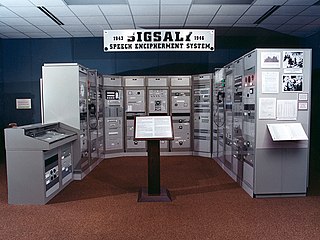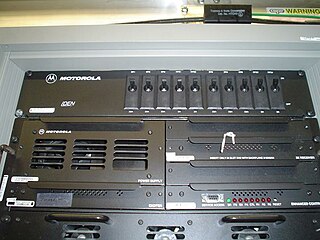A British voice encryption device used with (for example) Larkspur radio system sets.

Larkspur was the retrospectively adopted name of a tactical radio system used by the British Army. Its development started in the late 1940s with the first equipments being issued in the mid-1950s. It remained in service until replaced by Clansman in the late-1970s although some elements of Larkspur were still in service well into the 1980s. It was widely exported to British Commonwealth armies and other friendly nations.
BID means 'British Inter Departmental'. These systems or equipment types were generally used by more than one single governmental agency or department. The authority for BID's was the Communications-Electronics Security Group (CESG) who were part of Government Communications Headquarters (GCHQ).

The Government Communications Headquarters (GCHQ) is an intelligence and security organisation responsible for providing signals intelligence (SIGINT) and information assurance to the government and armed forces of the United Kingdom. Based in "The Doughnut" in the suburbs of Cheltenham, GCHQ is the responsibility of the country's Secretary of State for Foreign and Commonwealth Affairs, but it is not a part of the Foreign Office and its director ranks as a Permanent Secretary.
The BID/150 speech encryption key generator is a single channel device for use with the British Army C42 and C45 Larkspur radio system. This was the first Combat Net secure speech system whose key was set through the use of punch cards within the device. Examples of the BID/150 are on display at the Royal Signals Museum, Blandford Forum.

Blandford Forum, commonly Blandford, is a market town in the North Dorset district of Dorset, England, sited by the River Stour about 13 mi (21 km) northwest of Poole. It is the administrative headquarters of North Dorset District Council.
It was first used operationally by the 15th Signal Regiment during the Aden crisis in the late 1960s and was widely used from battalion level up to corps headquarters. It remained in use until the early 1980s.
In secure mode the analogue speech signal is digitized, then encrypted by combination with the digital key generated by the BID/150; the digital stream is then fed to the transmitter, to pulse modulate the carrier. On receive, the sequence is reversed.
Good radio performance was needed for reliable secure working. To this end, vehicles carrying the C42-DM-BID/150 system were issued with a 27-foot mast and an elevated antenna. The set carried a 'Goodman Box', to check signal strengths and antenna performance. The operator had searching set-up and performance drills to be strictly followed.

Communications security is the discipline of preventing unauthorized interceptors from accessing telecommunications in an intelligible form, while still delivering content to the intended recipients.

In telecommunications, a repeater is an electronic device that receives a signal and retransmits it. Repeaters are used to extend transmissions so that the signal can cover longer distances or be received on the other side of an obstruction.
In telecommunications, a scrambler is a device that transposes or inverts signals or otherwise encodes a message at the sender's side to make the message unintelligible at a receiver not equipped with an appropriately set descrambling device. Whereas encryption usually refers to operations carried out in the digital domain, scrambling usually refers to operations carried out in the analog domain. Scrambling is accomplished by the addition of components to the original signal or the changing of some important component of the original signal in order to make extraction of the original signal difficult. Examples of the latter might include removing or changing vertical or horizontal sync pulses in television signals; televisions will not be able to display a picture from such a signal. Some modern scramblers are actually encryption devices, the name remaining due to the similarities in use, as opposed to internal operation.

In electronics and telecommunications, a transmitter or radio transmitter is an electronic device which produces radio waves with an antenna. The transmitter itself generates a radio frequency alternating current, which is applied to the antenna. When excited by this alternating current, the antenna radiates radio waves.

Multichannel Multipoint Distribution Service (MMDS), formerly known as Broadband Radio Service (BRS) and also known as Wireless Cable, is a wireless telecommunications technology, used for general-purpose broadband networking or, more commonly, as an alternative method of cable television programming reception.
A security protocol is an abstract or concrete protocol that performs a security-related function and applies cryptographic methods, often as sequences of cryptographic primitives. A protocol describes how the algorithms should be used. A sufficiently detailed protocol includes details about data structures and representations, at which point it can be used to implement multiple, interoperable versions of a program.

In cryptography, SIGSALY was a secure speech system used in World War II for the highest-level Allied communications.
The National Security Agency took over responsibility for all U.S. Government encryption systems when it was formed in 1952. The technical details of most NSA-approved systems are still classified, but much more about its early systems have become known and its most modern systems share at least some features with commercial products.
The Secure Communications Interoperability Protocol (SCIP) is a multinational standard for secure voice and data communication, for circuit-switched one-to-one connections, not packet-switched networks. SCIP derived from the US Government Future Narrowband Digital Terminal (FNBDT) project after the US offered to share details of FNBDT with other nations in 2003. SCIP supports a number of different modes, including national and multinational modes which employ different cryptography. Many nations and industries develop SCIP devices to support the multinational and national modes of SCIP.

Secure voice is a term in cryptography for the encryption of voice communication over a range of communication types such as radio, telephone or IP.
Bowman is the name of the tactical communications system used by the British Armed Forces.

A computer network is a digital telecommunications network which allows nodes to share resources. In computer networks, computing devices exchange data with each other using connections between nodes. These data links are established over cable media such as wires or optic cables, or wireless media such as Wi-Fi.

A radio repeater is a combination of a radio receiver and a radio transmitter that receives a signal and retransmits it, so that two-way radio signals can cover longer distances. A repeater sited at a high elevation can allow two mobile stations, otherwise out of line-of-sight propagation range of each other, to communicate. Repeaters are found in professional, commercial, and government mobile radio systems and also in amateur radio.

Clansman is the name of a combat net radio system (CNR) used by the British Army from 1976 to 2010.
Radiofrequency MASINT is one of the six major disciplines generally accepted to make up the field of Measurement and Signature Intelligence (MASINT), with due regard that the MASINT subdisciplines may overlap, and MASINT, in turn, is complementary to more traditional intelligence collection and analysis disciplines such as SIGINT and IMINT. MASINT encompasses intelligence gathering activities that bring together disparate elements that do not fit within the definitions of Signals Intelligence (SIGINT), Imagery Intelligence (IMINT), or Human Intelligence (HUMINT).

Radio is the technology of signalling or communicating using radio waves. Radio waves are electromagnetic waves of frequency between 30 hertz (Hz) and 300 gigahertz (GHz). They are generated by an electronic device called a transmitter connected to an antenna which radiates the waves, and received by a radio receiver connected to another antenna. Radio is very widely used in modern technology, in radio communication, radar, radio navigation, remote control, remote sensing and other applications. In radio communication, used in radio and television broadcasting, cell phones, two-way radios, wireless networking and satellite communication among numerous other uses, radio waves are used to carry information across space from a transmitter to a receiver, by modulating the radio signal in the transmitter. In radar, used to locate and track objects like aircraft, ships, spacecraft and missiles, a beam of radio waves emitted by a radar transmitter reflects off the target object, and the reflected waves reveal the object's location. In radio navigation systems such as GPS and VOR, a mobile receiver receives radio signals from navigational radio beacons whose position is known, and by precisely measuring the arrival time of the radio waves the receiver can calculate its position on Earth. In wireless remote control devices like drones, garage door openers, and keyless entry systems, radio signals transmitted from a controller device control the actions of a remote device.
The British Armed Forces operates a wide range of communications and information systems. Some of these are specialised military systems, while others are procured off-the-shelf. They fall into three main categories: satellite ground terminals, terrestrial trunk communications systems, and combat net radio systems. Every part of the Army and the uses combat net radio, but only the Royal Corps of Signals and the Royal Air Force operates trunk systems and multi-channel satellite communications.

NXDN is an open standard for public land mobile radio systems, that is systems of two way radios (transceivers) for bidirectional person-to-person voice communication, exclusively for use by police, fire, ambulance and other public safety organizations. It was developed jointly by Icom Incorporated and Kenwood Corporation. It is an advanced digital system using FSK modulation that supports encrypted transmission and data as well as voice transmission. Like other land mobile systems, NXDN systems use the VHF and UHF frequency bands.
In cryptography, electromagnetic attacks are side-channel attacks performed by measuring the electromagnetic radiation emitted from a device and performing signal analysis on it. These attacks are a more specific type of what is sometimes referred to as Van Eck phreaking, with the intention to capture encryption keys. Electromagnetic attacks are typically non-invasive and passive, meaning that these attacks are able to be performed by observing the normal functioning of the target device without causing physical damage. However, an attacker may get a better signal with less noise by depackaging the chip and collecting the signal closer to the source. These attacks are successful against cryptographic implementations that perform different operations based on the data currently being processed, such as the square-and-multiply implementation of RSA. Different operations emit different amounts of radiation and an electromagnetic trace of encryption may show the exact operations being performed, allowing an attacker to retrieve full or partial private keys.












